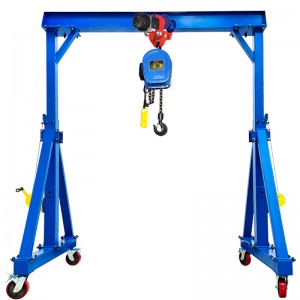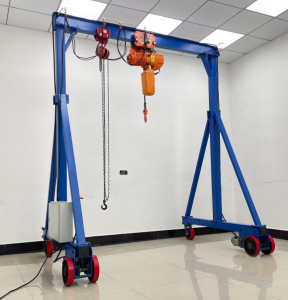When operating mobile gantry cranes in the aerospace and heavy equipment industries, there are several key safety considerations that must
1, Operator Training and Certification:
1) Crane operators must be properly trained and certified to ensure they have the necessary skills and knowledge to safely operate the mobile gantry crane.
2) This includes understanding load capacities, crane controls, load handling techniques, and emergency procedures.
2, Load Capacity and Weight Monitoring:
1) Ensuring the mobile gantry crane is not overloaded is critical. Operators must carefully calculate and monitor the weight of the load to prevent exceeding the crane's safe working load limits.
2) This is particularly important when handling heavy, irregularly shaped aerospace components or large, bulky heavy equipment.
3, Crane Stability and Leveling:
1) Mobile gantry cranes must be properly stabilized and leveled before lifting any load to prevent tipping or uncontrolled movement.
2) This may involve the use of outriggers, stabilizers, or other mechanisms to ensure the crane's stability, especially on uneven or sloped surfaces.
4, Overhead Clearance and Obstructions:
1) Operators must be aware of overhead clearances and potential obstructions, such as building structures, overhead power lines, or other equipment, to avoid collisions or contact during crane movements.
2) Proper planning and communication with the work environment are crucial to identify and mitigate these risks.
5, Controlled Load Movement:
1) Lifting, lowering, and maneuvering loads with a mobile gantry crane require precise control and coordination to prevent swinging, drifting, or unintended movements that could endanger workers or damage equipment.
2) Operators must be skilled in load handling techniques and have the ability to make smooth, controlled crane movements.
6, Maintenance and Inspection:
1) Regular maintenance and thorough inspections of the mobile gantry crane, including its structural components, hydraulic systems, and safety devices, are essential to ensure the crane's safe operation.
2) Any identified issues or defects must be promptly addressed before the crane is put back into service.
7, Safety Zones and Signaling:
1) Establishing and enforcing designated safety zones around the crane's operating area, with clear signage and communication protocols, can help prevent unauthorized personnel from entering the hazardous zone.
2) Effective signaling systems, such as warning lights or horns, can alert workers of crane movements and mitigate the risk of collisions or struck-by incidents.
By prioritizing these key safety considerations, organizations can effectively manage the risks associated with operating mobile gantry cranes in the aerospace and heavy equipment industries, ensuring the safety of workers and the protection of valuable assets.
Post time: Nov-12-2024






